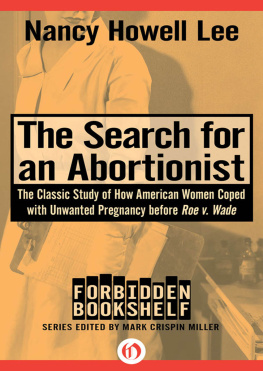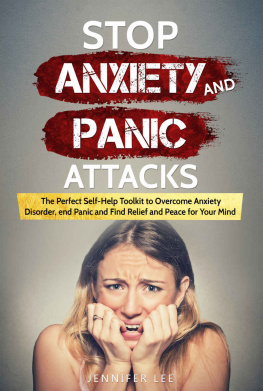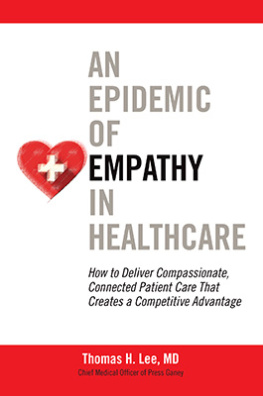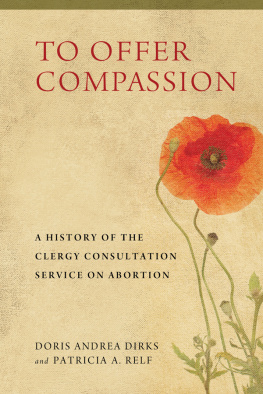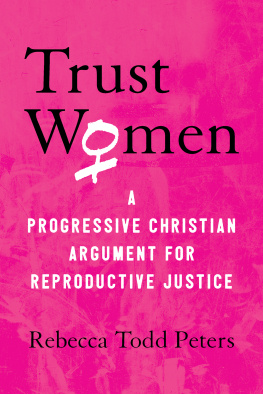The Search for an Abortionist
The Classic Study of How American Women Coped with Unwanted Pregnancy Before Roe v. Wade
Nancy Howell Lee
With a New Introduction by the Author

1
The Social Structure of Abortionin America
Somehow, in the mysterious way that issues appear and disappear from the public agenda, abortion has arrived on the scene as a lively and current topic of debate. Only a few years ago, serious discussions of abortion were met with indifference or disbelief, and investigators despaired of finding a rational response from the public. Today, it is widely acknowledged that abortion is one of the most common forms of illegal activity practiced in the United States, and revisions of the laws concerning abortion have been passed or are under consideration in many parts of the country. The explanation of why a subject is taboo at one time and au courant soon after is not obvious, and is, to a sociologist, as interesting a question as the practice of abortion itself.
Without attempting to explain the rapid change in interest and
At the same time that interest in changing the laws has been developing, there has been a revolution in contraceptive technology. The pill was first approved for prescription use in the United States in June 1960. By 1967, an estimated five million American women were taking the pills every month. can be drastically reduced and that the vast majority of unwanted pregnancies can be avoided before they occur.
The third factor involved in the increased interest in abortion is the promise of new pharmacological techniques of abortion. There have been numerous hints that a morning-after pill or a once-a-month pill will be available in the near future. Such a drug would eliminate the need for most operative abortions, legal or illegal.
Safe abortifacients, liberalization of abortion laws, and near-perfect contraceptive techniques may change the form of the abortion problem in the future, but they are utterly irrelevant to the experiences of the many women who have been seeking and finding abortions in the past and at the present time.
Of these women, we know very little. An accurate picture of the composition of the population of women who have abortions cannot be expected while abortion remains illegal and while people are understandably reluctant to answer questions which may place them in jeopardy. In the absence of accurate information based on random samples, a certain amount can be inferred from facts that are well established, or at least estimated on the basis of partial data. The size of the population of women who obtain deliberate abortions, for instance, is estimated as on the order of one million per year, although the true number may be as low as two hundred thousand or as high as two million.
Of the women who get abortions, it is clear that not all, by any means, are unmarried women escaping illegitimacy. Studies of some groups, like the Kinsey group and various birth-control clinic populations, suggest that while the abortion rate is higher for unmarried women, married women, especially those who have had all the children they choose to have, probably obtain the majority of all abortions. Nor is abortion exclusively or even primarily an activity of one social class or another. Substantial numbers of both rich and poor women are known to obtain abortions.
The fact is that many people in the society manage to arrange an illegal abortion when they wish it, including vast numbers who are ordinarily law-abiding and perfectly respectable. This offers a some what startling perspective on our sometimes naive notions of how a complex society operates and how people operate within a complex society. The task of arranging an abortion is not a simple one. Whether or not the abortion seekers are aware of it, there is an effective time limit operating on the search for an abortionist. Most abortionists refuse to accept cases in which the pregnancy is advanced beyond the twelfth week, when induced abortions become more difficult and dangerous to perform. Since the pregnancy shows no signs before two weeks, and is rarely confirmed before five or six weeks, those seeking abortion usually have less than six weeks in which to make a decision, locate an abortionist, raise whatever money is necessary, and have the abortion carried out.
This is a tight schedule of eventsevents which are complicated, difficult, and time-consuming. It is surprising, on one level, that such a large number of people are willing to undertake the risks of an illegal abortion rather than carry out the pregnancy. It is even more surprising, when one thinks about it, that hundreds of thousands of times each year people manage this complicated procedure, in the absence of institutional facilities to help them. One would think that the sheer level of activity generated by so many people carrying out such a demanding task would make abortion a highly visible activity in the society. Yet outside certain small circles, abortion is carried on almost invisibly. Many people know of a few cases among their friends and acquaintances; most physicians know of a larger number; and a few cases come to wide public attention when the patient dies or is taken to a hospital seriously ill. But still it is true to say that a very small amount of public notice is generated by what must be a great deal of activity.
Part of the explanation for the invisibility of abortion is that the participants, both patients and abortionists, are trying to keep it quiet to avoid confrontation with the law. Even the best intentions to keep it secret would not be successful, however, if it were not also true that the provision of illegal abortions is extremely decentralized. Each case is handled in an ad hoc way, working through the personal connections that individuals happen to have established before the need for abortion arose. Some of those who obtain abortions do not need to search for an abortionist, either because they find that they can have a legal hospital abortion, because they use self-induced techniques to perform it themselves, or because they happen to have access to a practicing abortionist. The vast majority of women, however, have to locate a specialist in abortion, an illegal practitioner who is willing to take the risks of breaking the law. These illegal practitioners, of course, cannot advertise their practice or make it freely available to their potential customers for fear of attracting the attention of law-enforcement agencies. Some abortionists are extremely surreptitious, operating from transient locations like hotel rooms and concealing their identity, even from their customers, by false names and even masks, while others remain in the same location for years and depend upon the loyalty and discretion of their customers to protect them from the law. In any case, there are no publicly available channels like the yellow pages of the telephone directory which permit potential customers to locate abortionists. In order to find an abortionist, most people seem to ask their friends and acquaintances for leads, people who may not have information about abortionists but who do have the kind of relationship to those seeking abortion that motivates them to try to help and to keep quiet about it. To have an abortion, it is not necessary, initially, to know of an abortionist. Instead, one need only search through ones own acquaintances to find a person who has had some experience with abortion in the past. If there are no such persons among ones acquaintances, it is very likely that there will be among the acquaintances of those acquaintances. In this way, the individual asks for help from persons known to him or at least comes with an introduction from someone they both know. The activity is relatively invisible because the searches can be conducted through the channels of private conversations, telephone calls, and personal letters. The search, starting from ordinarily law-abiding citizens, can reach through a number of intermediary steps to an illegal practitioner without ever requiring the search to come into the public domain and involve a confrontation of strangers agreeing on an illegal activity.

